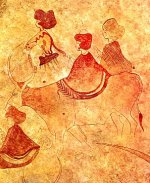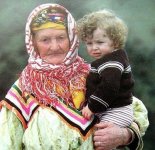I have recently proposed a novel theory regarding the origins of haplogroup R1b. I believe that R1b1 (P25) people might have been among the first people to domesticate cattle in eastern Anatolia and northern Mesopotamia/Syria during the Pre-Pottery Neolithic period. I suggested that the P297 branch moved north across the Caucasus to seek grazing grounds for their cattle, while the V88 branch migrated south to the Levant, then to Africa, following the Nile Valley until the Sahel, then spreading westward. R1b-V88 is found today at relatively high frequencies among several ethnic groups from the Sudan and Sahel, such as:
- the Hausa (40% of R1b-V88 in Sudan + 15.6% of B, 12.5% of A, 12.5% of E1b1a and 3% of E1b1b // 20% of R1b-V88 in northern Nigeria), speakers of of Chadic languages.
- the Fulani/Fulbe (54% of R1b-V88 in Sudan + 35% of E1b1b, mostly E-V22 // 14% of R1b-V88 in Niger), speakers of a Senegambian language.
- the Kirdi (from 40 to 95% of R1b-V88 in northern Cameroon), speakers of Chadic languages.
- Egyptian and Libyan Berbers (27% of R1b-V88 in Siwa, at the border of Egypt and Libya), speakers of a Semitic language.
Unfortunately I could only find mtDNA data for the Fulani and Berbers. The Egyptian and Libyan Berbers have haplogroups H1 and H3.
The Fulani
The Fulani people have clearly Caucasoid features, intermediary between Near Eastern (long, aquiline nose) and North African, a result of the blend of Near Eastern R1b with North African E-M78 and mtDNA M1 and L.
Having a look at the maternal lineages of the Fulani could give us a glimpse of what mtDNA the original R1b people carried some 10,000 years ago. It turns out that they carry very European, rather than Near Eastern, haplogroups, including U5, V, H, and J1b.
The data is from Černý et al. 2006 (samples from Chad, Cameroon and Burkina Faso, n=186) and Černý et al. 2011 (same as previous + Niger).
The following Eurasian haplogroups were found among the Fulani : J1b (17x in all four countries), U5 (11x in Chad, Niger and Burkina Faso), V (2x in Cameroon and Chad), U3a (1x in Niger), U6a (1x in Burkina Faso). Černý et al. 2006 mentioned in the abstract that mtDNA H lineages were found, but the more detailed 2011 study does not list any H sample. One sample from Niger could be H, but is undetermined.
Afonso et al. 2004 also found J1 and U5 in Sudan, which has large Fulani and Hausa populations. Unfortunately, the article does not mention which mtDNA belongs to which ethnic group.
U5 and V are typical of Mesolithic Europeans, but are also found in Northwest Africa as well as among most North Asian peoples. They are the two main haplogroups of the Sami. Haplogroup V has been found as far east as Korea and Japan.
Based on these mtDNA maps of Africa (p.12), U5 is by far the most common non-African lineage among the Fulani
J1b and U3 are the more typically Middle Eastern lineages.
U3 is found primarily around the Black Sea, which is the extended homeland of R1b from the Mesolithic to the Bronze Age. It is therefore not surprising to find it among R1b populations in Africa, although U3 is also associated with other Near Eastern Y-haplogroups like J1, J2 and T. Haplogroup U3 was one of the first mtDNA lineages that I listed as potential maternal equivalents of R1b. Nevertheless, I always believed that U3 was a very minor maternal lineage of R1b.
What's more the U3 sample from Niger may not even be related to R1b, since the Fulani population that tested positive for R1b was in Sudan, and other Fulani tribes from Burkina Faso (next to Niger) had no R1b, but did have 8% of haplogroup T. I believe that the correlation between Y-DNA T and mtDNA U3 is more likely in Africa than with R1b.
J1b is particularly common in Saudi Arabia (9.5%). What is interesting is that its coalescence age in Europe is very young, only 5000 years (+-2000 years), which corresponds almost exactly to the arrival of R1b in Europe during the Bronze Age. No J1b has been found to date in Europe before the Bronze Age. The oldest samples date from the Unetice and Urnfield cultures, two cultures that I have linked to the diffusion of R1b.
In Europe, J1b peaks in Scotland (4%), which also has one of the highest percentages of R1b, but more importantly one of the highest ratio of ANE (Ancient North Asian) and Gedrosian autosomal DNA, two admixtures associated with the deep roots of haplogroup R in Asia.
If there really is any H among the Fulani, it could either have come from Northwest Africa (H1, H3), or from Neolithic Middle Eastern R1b (most likely H5a, although H4 and H6 are also possible).
The mtDNA of R1b-M269 that wasn't part of the R1b-V88 tribes
R1b people almost certainly picked up other maternal lineages in the Near East and/or Caucasus before moving to the Pontic-Caspian Steppe, or from the migration of Carpatho-Balkan people to the steppes during the Late Neolithic or Chalcolithic (G2a3b1, J2b2, T1a1a1a). These would have included typical haplogroups of the region like K (notably the ubiquitous K1a4), I, T2b, W, and X2.
Since haplogroups I and W haven't been found in Neolithic Europe to date, I would assume that they were picked up by R1b in eastern Anatolia or the Caucasus. The other could have come from 'Old Europe'.
Possible chronology of maternal lineages of R1b men
Late Upper Palaeolithic
R1b* men are mammoth and bison hunters in Eastern Europe, Siberia and/or Central Asia.
=> mtDNA U5 and V (like the Sami)
Early Neolithic
R1b1* settled in the northern Near East and starts domesticating cattle.
=> absorbs mtDNA J1b and U3
Neolithic to Early Bronze Age
R1b1c migrates to the Levant and Africa. Absorbs mtDNA L lineages in Africa.
R1b1b migrates to the North Caucasus and Pontic Steppe. Absorbs U2 and U4 lineages from R1a populations in the steppe. Absorbs K, T2b and X2 lineages from G2a3b1, J2b2 and T1 populations from the Balkans and Carpathians.
Middle to Late Bronze Age
R1b-L23 to L11 moves deeper inside Europe and absorbs various local Neolithic/Chalcolithic lineages.
- the Hausa (40% of R1b-V88 in Sudan + 15.6% of B, 12.5% of A, 12.5% of E1b1a and 3% of E1b1b // 20% of R1b-V88 in northern Nigeria), speakers of of Chadic languages.
- the Fulani/Fulbe (54% of R1b-V88 in Sudan + 35% of E1b1b, mostly E-V22 // 14% of R1b-V88 in Niger), speakers of a Senegambian language.
- the Kirdi (from 40 to 95% of R1b-V88 in northern Cameroon), speakers of Chadic languages.
- Egyptian and Libyan Berbers (27% of R1b-V88 in Siwa, at the border of Egypt and Libya), speakers of a Semitic language.
Unfortunately I could only find mtDNA data for the Fulani and Berbers. The Egyptian and Libyan Berbers have haplogroups H1 and H3.
The Fulani
The Fulani people have clearly Caucasoid features, intermediary between Near Eastern (long, aquiline nose) and North African, a result of the blend of Near Eastern R1b with North African E-M78 and mtDNA M1 and L.
Having a look at the maternal lineages of the Fulani could give us a glimpse of what mtDNA the original R1b people carried some 10,000 years ago. It turns out that they carry very European, rather than Near Eastern, haplogroups, including U5, V, H, and J1b.
The data is from Černý et al. 2006 (samples from Chad, Cameroon and Burkina Faso, n=186) and Černý et al. 2011 (same as previous + Niger).
The following Eurasian haplogroups were found among the Fulani : J1b (17x in all four countries), U5 (11x in Chad, Niger and Burkina Faso), V (2x in Cameroon and Chad), U3a (1x in Niger), U6a (1x in Burkina Faso). Černý et al. 2006 mentioned in the abstract that mtDNA H lineages were found, but the more detailed 2011 study does not list any H sample. One sample from Niger could be H, but is undetermined.
Afonso et al. 2004 also found J1 and U5 in Sudan, which has large Fulani and Hausa populations. Unfortunately, the article does not mention which mtDNA belongs to which ethnic group.
U5 and V are typical of Mesolithic Europeans, but are also found in Northwest Africa as well as among most North Asian peoples. They are the two main haplogroups of the Sami. Haplogroup V has been found as far east as Korea and Japan.
Based on these mtDNA maps of Africa (p.12), U5 is by far the most common non-African lineage among the Fulani
J1b and U3 are the more typically Middle Eastern lineages.
U3 is found primarily around the Black Sea, which is the extended homeland of R1b from the Mesolithic to the Bronze Age. It is therefore not surprising to find it among R1b populations in Africa, although U3 is also associated with other Near Eastern Y-haplogroups like J1, J2 and T. Haplogroup U3 was one of the first mtDNA lineages that I listed as potential maternal equivalents of R1b. Nevertheless, I always believed that U3 was a very minor maternal lineage of R1b.
What's more the U3 sample from Niger may not even be related to R1b, since the Fulani population that tested positive for R1b was in Sudan, and other Fulani tribes from Burkina Faso (next to Niger) had no R1b, but did have 8% of haplogroup T. I believe that the correlation between Y-DNA T and mtDNA U3 is more likely in Africa than with R1b.
J1b is particularly common in Saudi Arabia (9.5%). What is interesting is that its coalescence age in Europe is very young, only 5000 years (+-2000 years), which corresponds almost exactly to the arrival of R1b in Europe during the Bronze Age. No J1b has been found to date in Europe before the Bronze Age. The oldest samples date from the Unetice and Urnfield cultures, two cultures that I have linked to the diffusion of R1b.
In Europe, J1b peaks in Scotland (4%), which also has one of the highest percentages of R1b, but more importantly one of the highest ratio of ANE (Ancient North Asian) and Gedrosian autosomal DNA, two admixtures associated with the deep roots of haplogroup R in Asia.
If there really is any H among the Fulani, it could either have come from Northwest Africa (H1, H3), or from Neolithic Middle Eastern R1b (most likely H5a, although H4 and H6 are also possible).
The mtDNA of R1b-M269 that wasn't part of the R1b-V88 tribes
R1b people almost certainly picked up other maternal lineages in the Near East and/or Caucasus before moving to the Pontic-Caspian Steppe, or from the migration of Carpatho-Balkan people to the steppes during the Late Neolithic or Chalcolithic (G2a3b1, J2b2, T1a1a1a). These would have included typical haplogroups of the region like K (notably the ubiquitous K1a4), I, T2b, W, and X2.
Since haplogroups I and W haven't been found in Neolithic Europe to date, I would assume that they were picked up by R1b in eastern Anatolia or the Caucasus. The other could have come from 'Old Europe'.
Possible chronology of maternal lineages of R1b men
Late Upper Palaeolithic
R1b* men are mammoth and bison hunters in Eastern Europe, Siberia and/or Central Asia.
=> mtDNA U5 and V (like the Sami)
Early Neolithic
R1b1* settled in the northern Near East and starts domesticating cattle.
=> absorbs mtDNA J1b and U3
Neolithic to Early Bronze Age
R1b1c migrates to the Levant and Africa. Absorbs mtDNA L lineages in Africa.
R1b1b migrates to the North Caucasus and Pontic Steppe. Absorbs U2 and U4 lineages from R1a populations in the steppe. Absorbs K, T2b and X2 lineages from G2a3b1, J2b2 and T1 populations from the Balkans and Carpathians.
Middle to Late Bronze Age
R1b-L23 to L11 moves deeper inside Europe and absorbs various local Neolithic/Chalcolithic lineages.
Last edited:




